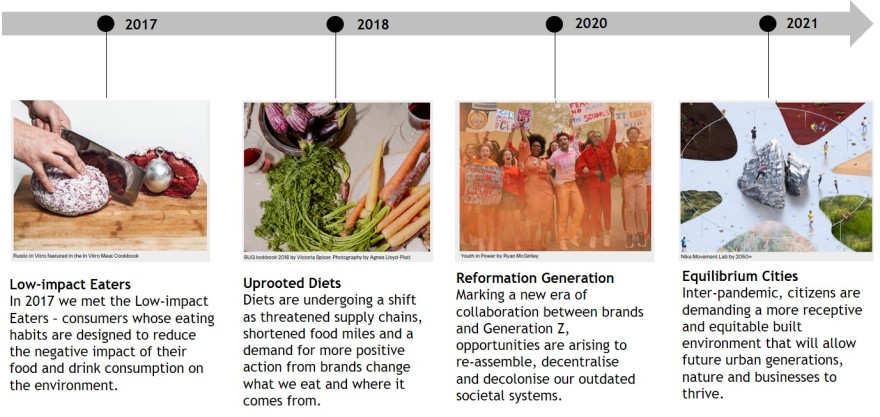Redemptive Diets
15 Mar 2022
Pathways to an improved global food system
In a time of global upheaval, brands and consumers are joining forces to build a sustainable, resilient food system that supports societal value change, protects precious resources and secures supply chains. This is a response to the commercialisation of food over the last century, where the cultural, social, environmental and political value of eating and drinking has been largely replaced by the pursuit of unbalanced business goals such as profit and gain and growth.
As the recent EY Future Consumer Index shows, 80% of global consumers believe brands must be transparent about the environmental impacts of the production of their goods and services, while 38% believe businesses should prioritise responsible production and consumption of goods and services.
It is therefore necessary to find new approaches and attitudes to our food system and to explore the reasons why we eat - and how we should eat. The aim is for businesses and consumers to develop people- and environmentally-friendly practices and to combine them with bold solutions.

Black Urban Growers and the National Black Food and Justice Alliance at Norman’s farm by Nydia Blas, Atlanta
What are the global drivers?
Climate change
The accelerating climate crisis is forcing the industry to adapt quickly to a range of supply chain and resource issues. Access to water will play a central role. The UN has projected that 1.8 billion people will be affected by absolute water scarcity, while two-thirds of the world's population will be water-stressed by 2025. Almost 2.37 billion people will not have access to sufficient food by 2020 (source: UN Food and Agriculture Organisation).
Global versus local
Supply disruption is accelerating hyperlocalisation, as increased hardship drives people to turn to their local communities for food growing and access. Singapore, which imports 90% of its food needs, has committed to building new systems that will ensure that 30% of its food is grown locally by 2030. (Source: Singapore Food Agency)
Evolving Demographics
Marginalised groups are seeking to address major structural inequalities, such as access to and protection of fresh, healthy food and traditional practices. For example, the purchasing power of the Hispanic population has increased by 212 per cent since 2000. (Source: Acosta/Newswise)
Development 2021-2024
As the role of food in meeting human needs is challenged by global events, actors across the food supply chain must redress the balance to provide socially, culturally and environmentally enriching solutions.
Cultural champions
With global efforts to build inclusive societies, a new wave of food brands and food initiatives is emerging that seek to build a personal relationship with consumers by focusing on provenance and identity. "To understand food in India, for example, you have to include caste, religion and culture," explains Priya Mani, author of the Cookalore Visual Encyclopaedia of Indian Cuisine.
Learning from the ancestors
Traditional methods of food procurement such as foraging are coming into the public eye as cultural identity, respect for nature, and structural inequality in food are moving up the public agenda. In 2020, there was an 89% increase in terms of interest in traditional food sourcing on UK social media (Source: Waitrose & Partners).
Global water demand
Food companies are stepping up to tackle the world’s water problem, foreseeing the business impact that this will have not only on production but on the survival of wider society. By 2050, global water demand is expected to increase by 55%, mainly due to growing demand from manufacturing industries (+400%, source: OECD). "The lack of safe, clean water around the world is one of the most pressing issues facing our global community," says Jim Andrew, sustainability officer, PepsiCo.
Equitable Eating
How and what we eat is becoming a political act. Now a new generation of activists is creating emergent ecosystems and networked communities centred on food provision and access.
Anthro-tech Agriculture
Food tech companies are realising the benefits of partnering with traditional landowners to protect and improve food culture and preserve ancestral knowledge. Chilean start-up The Live Green Co combines AI and ancestral knowledge and wisdom to reformulate products to replace animal-based, synthetic and unhealthy ingredients.
Elastic Agronomy
As the effects of climate instability are felt around the world, new solutions are emerging to support fragile supply chains and resources that would otherwise suffer irreparable damage or go extinct. The 2020 California wildfires cost the wine industry an estimated £2.7 billion ($3.7 billion, €3.1 billion). Source: bw166
Looking to the future: 2025-2030
The 2030s will see a protectionist approach to food, ranging from planet- and people-friendly diets to innovations in extreme propagation for long-extinct foods.
Cultivation Spaces
In the 2030s, areas of cultivation in our cities will become places of connection, education and shared meals. This is how self-sustaining venues emerge from the pandemic shift towards re-localisation. "Locally produced food can be distributed more efficiently, reducing the risk of food insecurity while creating local jobs," explains Nicoletta Batini, Economist, IMF.

Polydome is a greenhouse that can adapt to different environmental conditions, such as arid climates or water scarce regions.
Flavour museums
In the second half of the 2020s, museums will emerge to commemorate the flavours and ingredients that society once took for granted but have become extinct due to the climate crisis and resource scarcity. Two out of five plants on Earth are at risk of extinction and human activity is accelerating the loss of biodiversity Source: Royal Botanic Gardens: Kew
Climatarian diets
In the future, governments and brands will reward people for consciously reducing the environmental impact of the food they buy and consume, driving the growth of climate-friendly diets. 67% of consumers would support the introduction of carbon labelling on products (source: Carbon Trust). And Bloomberg Intelligence estimates that plant-based foods will account for 7.7% of the global protein market by 2030.
Desert Superfoods
As the food sector grapples with water scarcity and a warming planet, the desert is becoming an unlikely hotspot for future agriculture, while 'green walls' in Africa will help cool the region. By 2030, the UK could lack 6 million hectares of land to meet demand for food, housing and green energy says the Cambridge Institute for Sustainability Leadership. Desertification from human activity and climate variability has degraded 24% of the world's land, according to UN research. The first signs of what will be possible in the next decade can be seen in Dubai, where the International Center for Biosaline Agriculture (ICBA) is planting and growing salt-preferring foods in the desert to expand food diversity.
History of Macro Trends

Copyrights: LS:N Global, The Future Laboratory, By Savannah Scott, Petah Marian and Kathryn Bishop

